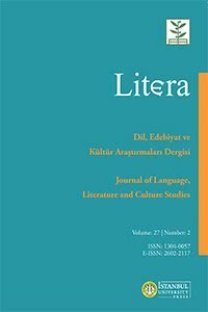Polysemy and Dichotomy of the Bridge in Ödön von Horváth’s Hin und her
The plot of Ödön von Horváths play Hin und her (1933) takes place on a bridge that represents a border between two countries. The protagonist is for administrative reasons forced to leave his country of residence and go across the bridge to the country where he was born. Since he has lost his citizenship and has no valid papers, he is not admitted back into his homeland and gets stuck on this bridge. He runs back and forth from one side to the other in hopes that he will be allowed to enter either of the two countries, so the bridge he finds himself on represents a place of exile and migration, but also a place of sanctuary. This paper examines the multilayered metaphor of a bridge as a place of hybridity and a heterotopia as Michel Foucault defines it. The bridge is smultaneously a place of separation as well as connection; it is a place of despair because the protagonist cannot cross it, but also a place of refuge and a means to get back to his homeland. In view of the current blurring and disappearance of ethnic and cultural differences in the process of globalzation and as a result of great global migrations, the metaphor of the bridge seems to be quite attractive. This is visible also in the numerous times the play can be found on theatre repertoires in German-speaking countries now, proving its relevance for the current situation.
Keywords:
bridge, Ödön von Horváths, hybridity, non-place heterotopia,
___
Augé, M. (1994). Orte und Nicht-Orte– Vorüberlegungen zu einer Ethnologie der Einsamkeit. Frankfurt am Main: Fischer Verlag.Certeau, M. de (2006). Praktiken im Raum. In J. Dünne und S. Günzel (Hg.) Raumtheorie: Grundlagentexte aus Philosophie und Kulturwissenschaften (S. 343-353). Frankfurt am Main: Suhrkamp.
Csaky, M. (2011). Kultur als Kommunikationsraum – am Beispiel Zentraleuropas. Zeitschrift für Mitteleuropäische Germanistik 1, 3-24.
Foucault, M. (1993). Andere Räume. In K. Barck et al. (Hrsg.), Aisthesis: Wahrnehmung heute oder Perspektiven einer anderen Ästhetik (S. 34-46). Leipzig: Reclam.
Horváth, Ö. von (1972). Hin und her. In T. Krischke und D. Hildebrandt(Hrsg.) Gesammelte Werke. Frankfurt am Main: Suhrkamp Verlag.
Lefebvre, H. (2006). Die Produktion des Raums. In J. Dünne und S. Günzel (Hrsg.), Raumtheorie: Grundlagentexte aus Philosophie und Kulturwissenschaften (S. 330 – 342). Frankfurt am Main: Suhrkamp.
Mach, E. (2014). Erkenntnis und Irrtum. Skizzen zur Psychologie der Forschung. Berlin: Edition Holzinger.
McGowan, M. (1997). Bosporus fließt in mir: Europa-Bilder und Brückenmetapher bei Aras Ören und Zehra Çirak. In H. Waldhoff et al. (Hrsg.), Brücken zwischen Zivilisationen: Zur Zivilisierung ethnisch-kultureller Differenzenund Machtungleichheiten/Das türkisch-deutsche Beispiel (S. 21-40). Frankfurt a.M.: IKO-Verlag für interkulturelle Kommunikation.
McGowan, M. (2004). Brücken und Brücken-Köpfe. Wandlung einer Metapher in der türkisch-deutschen Literatur. In M. Durzak et al. (Hrsg.), Die andere Deutsche Literatur: Istanbuler Vorträge (S. 31-40). Würzburg: Königshausen und Neumann.
Relph, E. (1971). Place and Placelessness. London: Pion Limited.
Simmel, G. (1957). Brücke und Tür.Essays des Philosophen zur Geschichte, Religion, Kunst und Gesellschaft. Stuttgart: K. F. Koehler Verlag.
Wenighofer, A. (2006). Grenzzwischenfall mit Nachspiel. Ödön von Horváths Hin und Her und die Nachlassmaterialien im Österreichschen Literaturarchiv. Uni.-Dipl. Wien.
Wildermann, P. (2019). „Ödön von Horváth Der Volksversteher.“ In: Der Tagesspiegel. URL: https://www.tagesspiegel.de/kultur/oedoen-von-horvth-der-volksversteher/24003704.html Letzter Zugriff 6.8.2020.
- Yayın Aralığı: Yılda 2 Sayı
- Yayıncı: İstanbul Üniversitesi
Sayıdaki Diğer Makaleler
“It’s all the Same What I Eat”: Jane Austen’s Dietary Philosophy
Haruki Murakami’nin Hipertextlerinde Performatif İşlevli Hikâye Anlatımı: Dün ve Şehrazad
Aleks MATOSOĞLU, Arsun URAS YILMAZ
Polysemy and Dichotomy of the Bridge in Ödön von Horváth’s Hin und her
B-M. Koltès’in Tabataba Oyununun Dramatik Yöntemle İletişimsel Açıdan İncelenmesi
“The Greatest Empresse of the East”: Hurrem Sultan in English Restoration Drama
The Shattering Symmetries between the Imaginary and the Symbolic in Carter’s The Magic Toyshop
